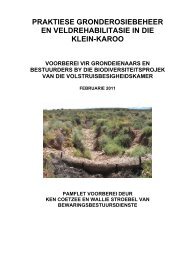REHABILITATION: REHABILITATION: A QUICK GUIDE A ... - saobc
REHABILITATION: REHABILITATION: A QUICK GUIDE A ... - saobc
REHABILITATION: REHABILITATION: A QUICK GUIDE A ... - saobc
You also want an ePaper? Increase the reach of your titles
YUMPU automatically turns print PDFs into web optimized ePapers that Google loves.
1. THE PRINCIPLES AND OBJECTIVES OF<br />
<strong>REHABILITATION</strong><br />
With the rehabilitation of four study sites, no attempt should be made to try and<br />
restore the sites to a pre-settlement condition. The rehabilitation should rather<br />
focus on the stabilization of soil erosion, the establishment of a dense and<br />
protective plant cover and the introduction of some of the more palatable plant<br />
species that were lost due to general habitat degradation.<br />
The general aridification of the soil has been the most important result of land<br />
degradation. Rehabilitation methods must thus focus on rehydration or methods<br />
that ensure that the maximum amount of rainwater infiltrates the soil. Decreasing<br />
runoff through the “capture” and retention of water is thus a primary objective.<br />
Establishing a soil protecting plant cover is another important objective.<br />
There is usually no single “quick-fix” miracle cure for veld degradation and the<br />
results are equally varied, ranging from severe gulley erosion systems to patches of<br />
unvegetated, capped soil. Soil chemistry varies from site to site, as does the soil<br />
subsurface and permeability and these factors all influence which plants will grow<br />
on the site. The design of rehabilitation treatments must thus also vary from site to<br />
site, and each site must have its own custom designed treatment, tailored for the<br />
site. Using the correct plants for revegetation is critical.<br />
No amount of rehabilitation treatment, however, can be successful if the cause of<br />
the degradation (which is the heavy, continuous overgrazing and trampling of<br />
ostriches) is not significantly reduced or removed. The complete or partial<br />
exclusion of ostriches from the rehabilitation camps, even if temporarily, is critical<br />
for any amount of rehabilitation success.<br />
The study areas under consideration are all part of actively farmed agricultural land.<br />
It is necessary to design a range of rehabilitation treatments that are both practical<br />
and affordable to ensure that they can be easily implemented by landowners who<br />
wish to rehabilitate their degraded veld.<br />
It is important, however, to appreciate that veld rehabilitation in the Little Karoo is a<br />
very slow process and that its success is largely dependent on climatic conditions<br />
following the rehabilitation work.<br />
It is also critical to appreciate that no veld rehabilitation plan be implemented as a<br />
once-off action. With veld rehabilitation, particularly the physical soil stabilization<br />
part, timeous follow-up maintenance of the soil erosion control structures, or<br />
treatments, is critical. Failure to do so will result in the failure of the project and a<br />
great deal of money wasted.<br />
1



